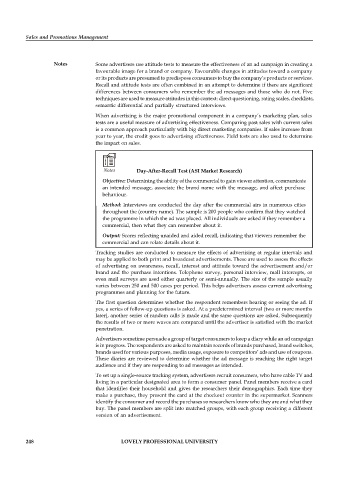Page 254 - DMGT507_SALES AND PROMOTIONS MANAGEMENT
P. 254
Sales and Promotions Management
Notes Some advertisers use attitude tests to measure the effectiveness of an ad campaign in creating a
favourable image for a brand or company. Favourable changes in attitudes toward a company
or its products are presumed to predispose consumers to buy the company’s products or services.
Recall and attitude tests are often combined in an attempt to determine if there are significant
differences between consumers who remember the ad messages and those who do not. Five
techniques are used to measure attitudes in this context: direct questioning, rating scales, checklists,
semantic differential and partially structured interviews.
When advertising is the major promotional component in a company’s marketing plan, sales
tests are a useful measure of advertising effectiveness. Comparing past sales with current sales
is a common approach particularly with big direct marketing companies. If sales increase from
year to year, the credit goes to advertising effectiveness. Field tests are also used to determine
the impact on sales.
Notes Day-After-Recall Test (ASI Market Research)
Objective: Determining the ability of the commercial to gain viewer attention, communicate
an intended message, associate the brand name with the message, and affect purchase
behaviour.
Method: Interviews are conducted the day after the commercial airs in numerous cities
throughout the (country name). The sample is 200 people who confirm that they watched
the programme in which the ad was placed. All individuals are asked if they remember a
commercial, then what they can remember about it.
Output: Scores reflecting unaided and aided recall, indicating that viewers remember the
commercial and can relate details about it.
Tracking studies are conducted to measure the effects of advertising at regular intervals and
may be applied to both print and broadcast advertisements. These are used to assess the effects
of advertising on awareness, recall, interest and attitude toward the advertisement and/or
brand and the purchase intentions. Telephone survey, personal interview, mall intercepts, or
even mail surveys are used either quarterly or semi-annually. The size of the sample usually
varies between 250 and 500 cases per period. This helps advertisers assess current advertising
programmes and planning for the future.
The first question determines whether the respondent remembers hearing or seeing the ad. If
yes, a series of follow-up questions is asked. At a predetermined interval (two or more months
later), another series of random calls is made and the same questions are asked. Subsequently
the results of two or more waves are compared until the advertiser is satisfied with the market
penetration.
Advertisers sometime persuade a group of target consumers to keep a diary while an ad campaign
is in progress. The respondents are asked to maintain records of brands purchased, brand switches,
brands used for various purposes, media usage, exposure to competitors’ ads and use of coupons.
These diaries are reviewed to determine whether the ad message is reaching the right target
audience and if they are responding to ad messages as intended.
To set up a single-source tracking system, advertisers recruit consumers, who have cable TV and
living in a particular designated area to form a consumer panel. Panel members receive a card
that identifies their household and gives the researchers their demographics. Each time they
make a purchase, they present the card at the checkout counter in the supermarket. Scanners
identify the consumer and record the purchases so researchers know who they are and what they
buy. The panel members are split into matched groups, with each group receiving a different
version of an advertisement.
248 LOVELY PROFESSIONAL UNIVERSITY

